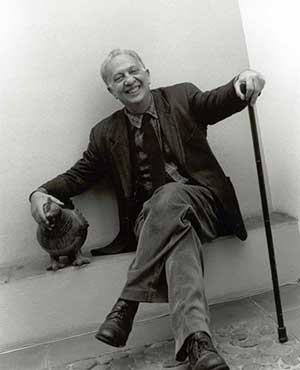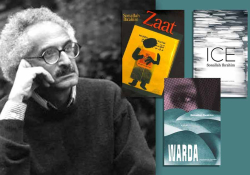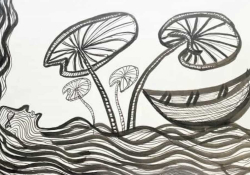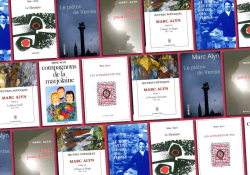To Escape, to Return: An Homage to Sergio Pitol

In the following tribute, the author offers a reading of Pitol’s masterwork, El arte de la fuga. “Escape—flight—fugue,” he writes; “the polyphony of the book is as much about freedom and imagination as it is about baroque, symphonic music, or about building, over the course of ten, fifty, or two hundred pages, multiple resonances and whorls of affect.”
Sometimes a book will strike you, as if from nowhere, with a kind of prescient weight, as if it was your destiny to read it in that time, in that place, and its contents will continue to reverberate through you, like an extra heartbeat, for the rest of your life. Recently I had such an encounter with an extraordinary book by the late Mexican author Sergio Pitol. I first heard of El arte de la fuga (The Art of Escape) a couple of decades ago; the book was Pitol’s masterwork, I was assured at the time, but for various reasons, most of them uninteresting, it would take me nearly twenty years to read it.[i] Somewhere between a memoir and an essay collection, El arte de la fuga blends fact and fiction into a series of startling, hybrid texts that abound with resonances and echoes. Pitol’s relaxed, personable tone belies the way that the book as a whole is an elegant and powerful critique of literary categories, either playing with abandon between them or dropping depth charges into their bellies; the book opens up pathways for literature as it opens up new pathways through your mind.
But most readers in English have probably never heard of Sergio Pitol. To say that he is one of Mexico’s greatest writers might not raise too many eyebrows either, given the anglophone world’s general ignorance of Mexican literature, notwithstanding a couple of poems by Octavio Paz or the odd Carlos Fuentes novel. But Pitol was indeed one of the great Mexican writers of the twentieth century. The author of over fifteen books, including novels, short-story and essay collections, at present he is one of only six Mexicans to have won the Cervantes Prize—known as the Spanish-language Nobel—and at the time when he won it, in 2005, only Fuentes and Paz had done so before him.
Pitol was born in 1933 and grew up in Veracruz, a long, thin state that curves along Mexico’s Caribbean coast. He moved to Mexico City to attend university; in between semesters he started travelling and soon fell in love with it. After he graduated, he spent years moving around Europe, working variously as a translator, editor, and writer, before finally gaining permanent employment as a cultural attaché for the Mexican diplomatic service. Like many other Latin American writers of his generation, Pitol lived through some of the major shifts in twentieth-century history in cities like Prague, Warsaw, and Moscow—cities that would come to dominate his literary topography. He returned to Mexico decades later and went back to Veracruz. In the early 1990s he moved to Xalapa, the state’s capital, where he assumed a teaching position at the Universidad Veracruzana. Progenitor of jalapeños, Xalapa is otherwise a largely unremarkable town nestled in a mountainous interior of jungles and coffee plantations.
* * *
I lived in Xalapa for a year in 2003. As part of an international studies degree at uni, I’d been studying Latin American culture and politics for a couple of years; the final component was to spend a year in Mexico in order to sharpen my Spanish, attend classes at the Universidad Veracruzana, and develop a couple of independent research projects. For the first months in Xalapa, however, it’s safe to say that I was more than a little traumatised. Mexico was overwhelming; it throbbed with an electricity that raised the hairs on your neck. And prior to actually going there, most of what I knew of the place was from intense, violent films like Traffic and Amores perros; after I arrived, it took me a while to realise that films like these constituted a fairly unhelpful education, and there were other, gentler, and more beautiful Mexicos than what I’d been led to believe. But for now, even little Xalapa made me tense. And my first research project was due soon; I needed to be getting out there, exercising my brittle Spanish, conducting interviews, catching buses to other towns, finding documents in archives. … I couldn’t bear to think about any of it; all I wanted was to hide in my room, listen to my CDs (I’d brought a big, heavy pile with me), and look at photos of my friends and family.
I had become friendly with one of my lecturers at the university, a young fiction writer who taught a class on Mexican literature. I can’t remember how, but he had discovered that I was also a writer and that I had, therefore, a little more invested in his course than the majority of students, most of whom were gringos on semester exchanges. One day after class, I must have mentioned the trouble I was having with my research project. Recently it had occurred to me that I could write some kind of biography or essay about a famous local writer. The task seemed appealing enough: it would be relatively easy to source books and reviews, and wouldn’t involve much intrepid data collection; I could do most of it at my desk. But other than my lecturer, I didn’t know of any writers in Xalapa.
– But one of Mexico’s greatest writers lives here, he told me.
– Really? Who?
– Sergio Pitol. He is a maestro. He has written many novels, short stories, essays. You could do your project on him.
– That sounds perfect! But how could I get in touch with him?
– Leave it with me, he said. I’ll see what I can do.
Sure enough, the following week my lecturer approached me after class.
– I spoke with Señor Pitol, he said. He is free now and is happy to see you.
– Now? I asked. Are you sure? I’m not even ready.
– Yes, yes, we have to go now. He is waiting.
I hadn’t done any preparation, and I was tired after the class and ready to go home. What’s more, I was wearing shorts, thongs, and a T-shirt—an Australian summer uniform that was so casual it was almost offensive in regional Mexico, and definitely not appropriate attire to wear to the house of a Great Mexican Writer.
– But I’m not dressed … I can’t … I don’t have a notepad.
– It’s okay, you can come like that. I have a dictaphone for you.
* * *

Pitol lived in a large but unostentatious house near the centre of town. He was elderly but not frail. He was lively and talkative, and didn’t seem to mind my clumsy Spanish, or my shorts. I interviewed him in his living room, where we sat opposite each other on large sofas and I asked a series of largely generic questions about his books—none of which I had yet read—and then about his life and his thoughts on writing. A lot of the references he made to his work went over my head, but I remember being particularly interested in his years as a young writer. Pitol didn’t publish his first story until his early twenties. I was twenty-three and had already starting publishing poems. But in my mind what I wanted most was to be a novelist. Or, more accurately, a famous novelist. Poetry was fine, or it was more than fine: it was essential as water, as air. But only through novels could glory be attained—where “glory” could have been anything from glorious size (your great brick sitting in the front window of a bookstore in Manhattan) to the fame of popular distribution (your brick adapted for a screenplay, becoming a major film). The fact that I had little interest in actually writing novels hadn’t occurred to me; instead, it concerned me that I didn’t yet have one in the works. So, the story of this Famous Novelist, who himself did not even start writing fiction until he was my age, told me that there was still time.
– Was it hard to publish your first story? I asked.
– Not really.
– Were you ever worried that you might not make it as a writer?
– No.
– Did you start writing later because you came to literature later?
– No. I was very sick as a child. I had malaria, which was untreatable back then. So I spent a lot of time in bed, and literature became my escape. I read everything. I always loved reading. But the desire to actually write stories of my own didn’t come until I was older.
Despite the fact that many of my questions were more about my own anxieties than about my interest in particular details of Pitol’s life, he answered each of my queries with warmth and patience, and we spoke until it grew dark and we could barely see each other. When at last I said that I had enough—actually, it was because the batteries for the tape recorder went flat—he gave me a tour around his home. It was a beautiful house, all ochre paint and woodwork, but what most impressed me—and I mean literally impressed, seared onto my brain—was a large room adjacent to the main living area: it was a library, an entire room devoted to books! In the middle were a couple of armchairs, but on all sides the walls were covered in shelves filled with thousands of titles. One shelf was English, another Spanish, another Polish, another German, another Russian … (Pitol spoke several languages and translated Austen, Chekhov, Conrad, James, and Nabokov, among many others). A whole room for reading, for nothing but reading. So powerful was this impression that it never left me, and I held on to it through all my years of renting, share-housing, travelling … until finally, when I moved into a new apartment a year ago, I was able, thanks to a house-warming gift from my mum, to line my entire living room wall with bookshelves, with too many bookshelves, enough bookshelves for at least a couple of decades. It was the realisation of a dream that had seeds in that meeting.
It was a beautiful house, all ochre paint and woodwork, but what most impressed me—and I mean literally impressed, seared onto my brain—was a large room adjacent to the main living area: it was a library, an entire room devoted to books.
Pitol gestured to the books of his favourite authors as if they were his closest friends and they had gathered to join us there in the library. In much the same way, El arte de la fuga abounds with references to Pitol’s literary ancestors; they inform not only how he writes, but they are, as he says of Chekhov, his “contemporaries” (217)—they infuse every moment of his waking life, they provide solace and immeasurable pleasure, their words leak into his dreams. Had I been aware of this at the time, I might have asked him about it, as opposed to just gawking at all the books on the shelves. Maybe the library wasn’t a private room but instead a very social one. So that the living room where we’d done the interview was for gathering friends and acquaintances, but the library was for loved ones, a family room.
It was dark by the time I left. As the maestro stood at his front door and waved me goodbye, he urged me to visit again. He was going away the following day, he said, but after he returned I should come back and see him. But I never did—a fact that, on reflection, confuses me deeply.
What I ended up writing for my “research project” was nothing of note. I read one or two of Pitol’s short stories, consulted a few articles from some rudimentary, early-millennium websites, and found a couple of references in the local library. Mostly what I wrote was a combination of conjecture—I knew it would be highly unlikely that whoever marked my assignment back in Sydney would have read Pitol—and translation—I took broader facts and themes from Mexican society and culture and clumsily overlaid them onto a reading of Pitol’s life. For instance, in one section I mentioned Pitol’s homosexuality, which I combined with the observation that being gay in Veracruz in the first half of the twentieth century would have been extremely difficult. I therefore claimed that the repression of Pitol’s sexuality as a young man caused him immeasurable trauma and was a central motivation in leaving Mexico for Europe. But I had no idea, and still have no idea, if this was actually true. I only know of a few instances where Pitol writes of his sexuality, or of homosexuality more broadly, but, reminiscent of gay Australian writers from the same era—Patrick White, David Malouf—these episodes are not darkened with trauma. Rather, they are simply expressions of desire.
Thinking of Pitol as I left him that day, living alone in a big house in a regional town in the latter years of his life, it would be tempting for us now to imagine the story of a sad, lonely gay man who was so persecuted by conservative, Catholic Mexico that he was forced to retreat into the world of books. But this would be false. Until his last years, much of Pitol’s life was immeasurably social and communal, and he loved Xalapa, Veracruz, and Mexico, as much for their people as their places. Indeed, in El Arte de la fuga, he traverses beloved terrain in central and eastern Europe, but he also delights in many of his Mexican memories, from heady days as a student and young writer in Mexico City, to a searing account of the Zapatista rebellion in Chiapas in the mid-1990s, which transformed his understanding of Indigenous Mexico. Pitol’s intimacies were local, national, international, and physical, speculative and imagined; he loved dogs, humans, and dead novelists; he queered the family, made it into a library.
Pitol’s intimacies were local, national, international, and physical, speculative and imagined; he loved dogs, humans, and dead novelists; he queered the family, made it into a library.
But I, of course, did not read El Arte de la fuga for my research, although it would have been invaluable. And this was probably part of why I never visited him again—my shame, that I had not taken the project very seriously, that I’d done as little as possible with what he had offered me. Still, I ended up doing well enough to get a decent, if not stellar, grade. Mainly, I think, my marker was excited by the fact that I’d managed to find a writer about whom so much could be written in Xalapa, a town sufficiently nondescript for an Australian university to feel comfortable about sending undergraduate students there every year. As I’d hoped, he’d never even heard of Pitol, so he had no idea of how many liberties I was taking with my postulations, or how little I really knew of the fiction. At any rate, it was enough for me to pass and to move on into the second half of the year. I went travelling through Central America for a few months, and soon the landscape of my life—as is so often the case with the young—had completely changed. There my encounter with Pitol would rest for much of the next seventeen years.
* * *
As I said, the series of circumstances that led me to return to Pitol’s work only recently, nearly two decades after I left Mexico, are not interesting or particularly relevant. Suffice to say that he remained in my head as a Writer I Must Read, but, like so many writers on that list, he struggled to climb up the ranks. I’d always known that I had to read El arte de la fuga in particular—my literature lecturer in Xalapa had told me that it was Pitol’s magnum opus, after all. But there were so many books in the world, how could I find the time?
In the decades after Mexico I came no closer to realising that juvenile dream of becoming a Famous Novelist. But I kept circling around different kinds of prose, drifting through it, getting stuck in it in different ways. Even though I was a poet, even though I used the term to identify my practice, I spent more—much more—of my time writing prose. There was this growing sense that somehow, as the pages of literary criticism, memoir, manifesto, and nonfiction began to mount, it would all need to cluster, to take shape. What was I doing? As I stepped in and out of these various forms, was I merely adopting different costumes, or was I slowly knitting together some kind of amalgam or metatext, the true extent of which I could not yet determine? I knew that I wanted something more open, more fluid than conventional fiction. I simply had no patience for the demands of exposition or character development or narrative frame; I wanted space for completely unfettered exploration and speculation, for sound and colour structures, for hive cognition, for an intergalactic text! At the same time, I didn’t want to be bound by the constraints of an argument and a canon of scholarship to which the argument needed to respond, either. Argument interested me, and I was certainly interested in reading the arguments of others, but I wanted to conceive of a text in which it was possible, for example, to make an argument and then to discard it entirely, or to make a series of arguments, none of which were necessarily related, or to respond to a preexisting argument with little more than a question, or an image, or a scene. In other words: generic conventions and formulas were fine, they could work well, sometimes beautifully, but I wanted to be able to use or combine or discard them if and when I saw fit.
Anyone who feels that the maps of genre are complete, that what is possible in fiction, memoir, or essay is more or less established, needs to read Pitol’s book.
To be sure, El arte de la fuga is a tremendous tonic for liberation. Anyone who feels that the maps of genre are complete, that what is possible in fiction, memoir, or essay is more or less established, needs to read this book. During his time in Poland as a cultural attaché at the Mexican embassy, the act of reading became for Pitol one of “pure hedonism” (16). Free of the weight of fashion, trends, cliques, he could read whatever he wanted, however he wanted. It is this same hedonism, this delight in the twists and turns of liberated imagination, that informs the structure of this remarkable book. From Poland, then, he turns to his youth, for its “innocence, blindness [and] intransigence”; then, he conceives of the future “as a zone of infinite, unknown promise” (18). Such delight in the agility of the mind, of its apparently limitless expansiveness, of how this infinity seems to fold the very infinity of the universe, feeds a bubbling, unbridled optimism in the work—for life, yes, but also for literature, for what it can do. Thus, narrative need not be locked into linear time, prose need not be locked into narrative; the chapters jump from recollection to theorisation to characterisation; as people loom then disappear, so too does Pitol as a character himself, along with all those other authors, some of whom form a kind of pantheon, a community of spirits to mirror a community of selves. So it is that he writes, at the start of a striking chapter about the power of hypnosis:
… a simple description, without additions, without delays, echoes or shadows, fatally reduces the power of the story, converts it into a mere anecdote—something vulgar, basically. Always, from the very beginning, what I have done is scatter a series of points across a white page, as if by chance they had fallen onto it, without any visible relation between them; until suddenly something begins to spread, to expand and throw out tentacles in search of the others, and then the rest follow its example: the points convert into lines that run across the page to find their siblings, whether to subordinate or to serve them, until that initial cluster of solitary points has transformed into an increasingly complex, intricate figure, with cavities, folds, reservations, blurring and dark flashes. (88–89)
A figure of complexity replete with cavities, folds, and chiaroscuro; this is Caravaggian, Leibnizian, Deleuzian; a Mexican neo-baroque. Later in the book, Pitol writes that “one of the triumphs of the Mexican baroque manifests in the complexity of Mexico City’s nightlife, controlled and performed as it is with an exorbitant imagination” (116). In turn, many of the essays excavate scenes from the author’s youth in the capital, full of impassioned, late-night conversations and cultural fermentation as pungent as anything in Bolaño’s Savage Detectives. But if a particular chapter might plunge into the smoky, neon-lit darkness of an inner-city bar, it will then suddenly leap, with infectious cheer, into the blinding light of a Caracas street, an art gallery in New York City, or an ecstatic account of Mayan-inflected Catholicism in San Cristóbal de las Casas.
Complexity must be constantly pushed into verb; it is a mode of conjunction and articulation, rather than a sterile concept that pops out of the mouth like a commonplace noun. Ever wary of the homogenising forces of authoritarianism, Pitol is not one for manifestos, or for outlining the form or method in which complexity must be made manifest; the most he will come to is an injunction that artwork express “the best energy” of the human (170). But this is a structural as well as an ideological or thematic issue: at the start of this essay I translated El Arte de la fuga as ‘The Art of Escape,” but fuga in Spanish is also fugue. Escape—flight—fugue; the polyphony of the book is as much about freedom and imagination as it is about baroque, symphonic music, or about building, over the course of ten, fifty, or two hundred pages, multiple resonances and whorls of affect, be they scratchy echoes (a reference to Faulkner here, a reference to Faulkner there) or crystalline harmonies that bind whole chunks of the work together (the verdant colours of memory; the companionship of friends).
For Pitol, then, the heart of great writing seems to lie in those volcanic flows that sustain the living forms of our language and thought, rather than in devoted attention to the forms themselves. Reminiscent of poet Nathaniel Tarn’s proposition that the poem is an attempt to unify multiplicity with a deeper, global mantra, for Pitol writing is about the possibility of fusing the external world with the subterranean one that lives inside of us (169). Those truly exceptional moments in literature come when the author “manages to be submerged by the deep currents of language in order … to lose the signs of his or her identity.” For Pitol as for E. M. Forster, then, at the heart of all great art is a yearning for anonymity:
The literary work becomes great when its author manages to find that dark current which carries traces of everything spoken since the language was born, that is, in the instant in which the writer feels s/he is transcribing a dictation, when the word produces its apparition before it is summoned. (172)
But if the great artist yearns for anonymity, surely as readers we want of great artists the very opposite—that is, we yearn to know them as well as their work. We are desperate for remarkable art, can’t get enough of it. For many, art is one of the few things that breaks the otherwise stultifying monotony of daily life; for many others, it is one of the most vital sources of affective power and intellectual rejuvenation.
But it is most unfortunate, I think, that Pitol seems to have gotten what he wanted. Shortly after finishing El arte de la fuga, I went online to see what others had to say about it. Most of the reviews were laudatory, but a couple also confirmed some of my suspicions, that my ignorance of Pitol’s later life was not just to do with the fact that I had fled Mexico, nearly overwhelmed by its cornucopia, but also because he remained overlooked and unseen by many of his contemporaries and by the Mexican public. Thus, despite the acclaim and the international prizes, he remains almost as little known within Mexico as outside of it. When people speak of great Latin American writers, in my experience they tend to list a fairly standard roll call of names that emerged in English in the middle decades of the twentieth century: people like the aforementioned Fuentes, but also Borges, Cortázar, García Márquez, Neruda, and Vallejo. If people ever talk about great Mexican writers, you’ll probably hear Paz, Rulfo, and Monsiváis mentioned next to Fuentes. At any rate, it’s basically unheard of to see Pitol in these lists. Worse than that, he isn’t read in Mexican schools, apparently, and his books are hard to find in shops. All this in less than a couple of decades since he won the Premio Cervantes. Peter Carey last won the Booker Prize in 2001; imagine if we’d forgotten about him by 2020?
Apart from the acclaim or lack thereof and how we might explain it or explain it away, what disturbed me the most during my search online was learning about what happened to Pitol in his last years. Quite soon after I had met him in Xalapa, his health began to deteriorate rapidly. He was overcome by an aggressive form of aphasia, which prevented him from writing or talking—an appalling sentence, really, not only for a writer but for someone whose life until then was always illuminated by the companionship and languages of myriad communities. After struggling for fifteen years, he died alone in his home on April 12, 2018, aged eighty-five.
Criticism—I mean the act of writing about and for literature, of loving it—should be foremost; before stories, before poetry, but because of them, too, there should be the community we love.
It is perhaps too glib a truism to say that the writing life can be a brutal one, where a human being’s greatest, most intimate work is subjected to the cursory, fleeting attentions of a fickle and generally impatient public. Even in the case of someone like Pitol, who experienced no difficulty in finding a publisher, in receiving invitations or support or winning prestigious prizes, it can all amount to little more than nada. “Memory,” Pitol writes in El arte de la fuga, “works with the same oblique, rebellious logic as dream. It rummages in hidden wells and from those extracts visions that, different to dreams, are almost always pleasurable” (57). But as much as our memories might please us, as much as we might pump them with nostalgia so that they balloon into grotesque, neckless versions of their former selves, it is also true that in memory we can see the mechanics of erasure, and in those memories we most cherish, perhaps, are machines so powerful that they can lay waste to the diverse, sticky webs in which they were first created. As readers and also as fellow writers, how can we find the time to properly honour and cherish the work of these beautiful minds? We can, I hope, always speak, at least of those who are special to us, and do our best to support others to do the same. Criticism—I mean the act of writing about and for literature, of loving it—should be foremost; before stories, before poetry, but because of them, too, there should be the community we love.
* * *
I did see Pitol one last time. It was towards the end of my year in Xalapa, many months after we had met for the interview. It was a bright, sunny day, and I was leaving the university with a small group of friends. We were laughing about something, probably joking about how little attention we’d paid to the class we’d just come from. As we were passing through the gate, I looked up for a moment and saw him standing there, not two metres away. He was looking at me with a subtle smile on his lips. He was about to say hello, I think, and his hand had started to raise. But I pretended not to see him. Squinting in the glare, I affected a kind of blindness; I looked through him, and then I returned my attention to my friends. I walked straight past, without so much as saying hello.
I keep trying to reenter that younger body, to remember what it was that stopped me from greeting him, from leaving my friends and beginning a conversation, possibly even some kind of friendship, with this strange, lovely man, but I cannot. I cannot.
Griffith University
[i] George Henson’s English translation, with which I am not familiar, was published by Deep Vellum in 2015 as The Art of Flight. All subsequent quotes are my translations from the original, published by Ediciones Era in 1996.
















